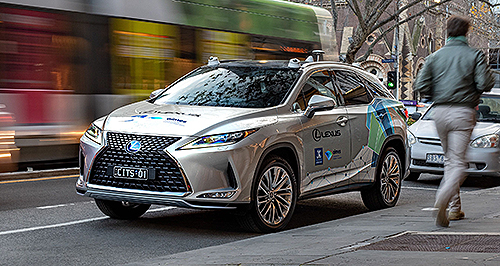Make / Model Search
News - LexusLexus backs Melbourne traffic communications testingTraffic research using V2V and V2X communication uses cars Lexus RXs23 Jul 2021 By NEIL DOWLING RESEARCH now underway in Australia to find road safety solutions for the future have included sophisticated vehicle-to-infrastructure communications that can for warn drivers of potential hazards ahead, including the presence of emergency service vehicles and changes to the road network like traffic lights and “hook turn” intersections.
The research is being undertaken in Melbourne by Australian Integrated Multimodal EcoSystem (AIMES), a collaboration of 50 government, transport and technology partners led by the University of Melbourne.
It is designed to test vehicle-to-vehicle and vehicle-to-infrastructure communications technology in a real-world environment with Lexus serving as the automotive testing partner.
The brand’s local arm has provided two RX450h SUVs fitted with dedicated short-range communication (DSRC) and cellular network technologies.
Software for the trial has been developed in Australia by Lexus Australia engineers specifically to address Melbourne’s unique traffic environment and regulations.
It is not the first time Lexus has been involved with this technology after successfully demonstrating DSRC technology for vehicle-to-vehicle (V2V) and vehicle-to-infrastructure (V2I) communications in Japan since 2015.
The two Lexus SUVs, driving around a special test precinct in the Melbourne suburb of Carlton, can communicate with traffic lights, trams and emergency service vehicles to proactively deliver warnings and alerts of potential danger to the driver before they enter the driver's line of sight.
The AIMES research is proving to be a bonus to Lexus, which now plans to use the trial to develop in-car applications, including warning the driver when turning in front of a tram, or a warning when a cyclist or pedestrian has pushed the button on traffic lights to cross the road.
Other possibilities are an alert when the driver attempts to enter a one-way street or freeway on/off-ramp in the wrong direction.
In a statement, Lexus said it will “develop and trial further applications”.
“Trialling how vehicles communicate with other vehicles and the local environment is critical to achieve a cohesive ecosystem between drivers and other road users to ensure drivers are delivered warnings of potential danger ahead of time,” it said.
“Trialling this technology targets a reduced risk of vehicles driving through red lights, turning into trams, or being unable to see pedestrians obstructed by traffic lights and other infrastructure before they step onto the road.”
Lexus Australia chief executive Scott Thompson said the company was committed to investment in a wide range of new technologies to achieve higher vehicle safety standards.
“Imaginative technology and leveraging innovation are core to the Lexus DNA, and we are committed to delivering next-generation road safety outcomes,” he said.
“Lexus would like to thank the Victorian and Queensland Government, and the University of Melbourne, for their partnership in developing important road safety research.”
The AIMES program follows previous C-ITS trials held in partnership with Lexus and the Victorian and Queensland governments that concluded in 2020.
In Victoria, Lexus Australia participated in the Advanced Connected Vehicles for Victoria project and in Queensland, worked with the Department of Transport and Main Roads (Queensland) Cooperative and Automated Vehicle Initiative (CAVI) in Ipswich.
The brand said those trials enabled it to develop applications such as warning drivers of red lights ahead, pedestrians about to cross the road at traffic lights, and alerting drivers to the presence of slow or stopped vehicles, road works or road hazards such as water or debris – elements that will continue to be tested in this trial.
The AIMES trial is centred in a six-square-kilometre area spanning Carlton, Fitzroy and Collingwood, bordered by Victoria Parade, Hoddle Street, Alexandra Parade and Lygon Street.
In addition to the connected vehicles, the AIMES trial area incorporates a network of smart sensors connecting public transport, pedestrians and cyclists, intersections, and streets into a fully integrated ecosystem.
In 2018 Lexus announced it would deploy the DSRC technology in all its US-bound vehicles by 2021. In early 2019, it announced it had suspended the program.  |
Click to shareLexus articlesMotor industry news |









Facebook Twitter Instagram